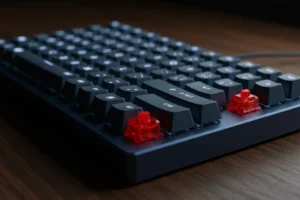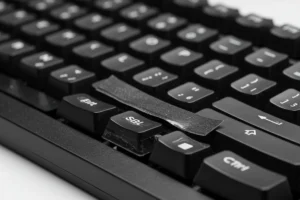Good evening everyone, today I want to talk a little about the technical part of keyboards, mainly the design of their letter numbering keys, etc.
As a massive keyboard enthusiast, I’ve always been fascinated by the process, and today, I’m taking you on an in-depth journey into how these essential devices come to life.
From concept to final product, every detail is carefully crafted to ensure that your typing and gaming experience is top-notch. Let’s dive into this exciting world and uncover all the secrets of keyboard design! 🔥
The Concept Stage: Where Ideas Are Born 💡
Before a keyboard even becomes a prototype, it all starts with an idea. Designers and engineers brainstorm the essential features, target audience, and intended use. They ask themselves questions like:
- Is this keyboard meant for gamers, typists, or general users? 🎮💻
- Should it be mechanical, membrane, or hybrid?
- What kind of switches will provide the best experience?
- What size and layout will be most ergonomic?
- Should it have RGB lighting, macro keys, or wireless connectivity?
This stage is all about research and market analysis. Companies study trends, user feedback, and competitor products to ensure they create something unique and functional.
For example, gaming keyboards often feature fast response times and programmable keys, while office keyboards prioritize comfort and quiet typing.

The Engineering Process: From Sketch to Prototype ✏️
Once the concept is finalized, engineers move on to designing the actual structure of the keyboard. This includes:
- PCB Design (Printed Circuit Board) – This is the heart of the keyboard, determining how keypresses are registered and processed.
- Switch Selection – Mechanical (like Cherry MX, Gateron, or Razer switches) or membrane? Each choice impacts feel, durability, and sound.
- Frame and Casing – Plastic, aluminum, or a premium metal build? This decision affects durability and aesthetics.
- Keycap Material – ABS vs. PBT plastic. PBT keycaps last longer and resist shine, while ABS can wear down faster but allows for more vibrant colors.
- Firmware and Software – Custom drivers, RGB settings, and macro configurations are programmed to enhance user customization.
During this stage, prototypes are made to test how everything fits together. Engineers ensure that key placement, actuation force, and overall usability meet expectations.
The Testing Phase: Making Sure Everything Works 🛠️
Before mass production begins, rigorous testing is performed. This ensures that the keyboard is durable, functional, and user-friendly. The testing process includes:
- Durability Tests – Keyboards are subjected to millions of keypresses to check longevity.
- Ergonomic Tests – How comfortable is the keyboard for long typing sessions?
- Gaming Performance Tests – Are the response times and anti-ghosting features working correctly?
- Water and Dust Resistance Tests – Some models come with waterproofing for extra protection.

Manufacturing and Assembly: Bringing the Keyboard to Life 🏭
Once a keyboard passes all tests, it moves into mass production. Factories handle:
- Injection molding for keycaps and casings
- Soldering and assembly of PCBs
- Final quality control checks
- Packaging and shipping to retailers
Many brands also incorporate unique branding, adding custom keycap designs, logos, and extra accessories like wrist rests or key pullers.
Popular Keyboard Brands and Their Designs 🏆
Some brands have set the gold standard for keyboard design, including:
- Corsair – Known for premium gaming keyboards with iCUE software.
- Logitech – Offers mechanical and membrane keyboards with high durability.
- Razer – Focuses on RGB lighting and custom mechanical switches.
- SteelSeries – Popular among eSports players.
- Keychron – A top choice for mechanical keyboard enthusiasts and Mac users.
Each brand has its unique approach, whether it’s ergonomic design, ultra-fast response times, or aesthetic customization.

The Future of Keyboards: What’s Next? 🚀
Keyboard technology is evolving rapidly. Some trends we’re seeing include:
- Optical switches for even faster actuation
- More compact layouts like 65% and 75% keyboards
- Wireless advancements with lower latency
- Eco-friendly materials and sustainable designs
- AI-powered predictive typing and smart integration
With these innovations, the way we interact with keyboards will only get better. I personally can’t wait to see what’s next!
FAQs ❓
▶ What makes mechanical keyboards better than membrane keyboards? Mechanical keyboards are more durable, offer better tactile feedback, and provide a superior typing experience compared to membrane keyboards.
▶ How long does it take to design a keyboard? The entire process, from concept to production, can take anywhere from 6 months to 2 years, depending on the complexity of the design.
▶ Are custom keyboards worth it? Absolutely! If you love personalization and top-tier performance, building or buying a custom keyboard can be a game-changer.
▶ Where can I find more information on keyboard design? You can check out Wikipedia’s page on keyboards for a deep dive into keyboard history and engineering.
See More
- The Best and Worst Mechanical Switches: A Tier List
- Mechanical Keyboard Brands Ranked from S-Tier to D-Tier
- How to Make Your Keyboard Quieter Without Replacing It
Final Thoughts 🏁
Keyboards are more than just tools – they’re essential extensions of how we work, play, and communicate.
I believe this article is more for those who are interested in the world of keyboards, I particularly enjoy talking about topics like this.
I’d love to hear your thoughts – what’s your favorite type of keyboard? Drop a comment below and let’s talk! 💬🔥
Oh, and if you liked this article, don’t forget to share it! 😊 Check out more keyboard content at Keyboards Technology! 🖥️✨


